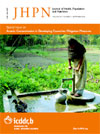
|
The Journal of Health, Population and Nutrition
icddr,b
ISSN: 1606-0997
EISSN: 1606-0997
Vol. 39, No. 1, 2020, pp. 1-16
|
 Bioline Code: hn20007
Bioline Code: hn20007
Full paper language: English
Document type: Research Article
Document available free of charge
|
|
|
The Journal of Health, Population and Nutrition, Vol. 39, No. 1, 2020, pp. 1-16
| en |
Aiming for better use of convenience food: an analysis based on meal production functions at home
Nakano, Satoshi & Washizu, Ayu
Abstract
Background: In recent years, the evaluation of convenience food has changed. It came to be considered not to
have a negative effect on health and is now positioned as a tool to support dietary habits of elderly and other
people. In advanced countries where the population is aging, convenience foods are expected to improve the
eating habits of the elderly.
Methods: We defined the indicators of cooking effort and usage intensity of convenience food and presented a
model wherein a “meal” is home-produced. In the model, a home cook decides the optimal cooking effort to apply
for a given usage intensity of convenience food. Using an empirical form of the proposed model, we performed a
multiple regression analysis and calculated “the elasticity of cooking effort with respect to the usage intensity of
convenience food” for home cooks, with each attribute defined by a combination of different personality and
demographic factors, using the estimated coefficients.
Results: Regression analysis results revealed a negative correlation between cooking effort and the usage intensity
of convenience food, which is consistent with our theoretical model of home meal production. The results showed
that home cooks who have special food preferences may not be satisfied with accepting convenience foods
purchased from the market as they are and that these home cooks will require a higher cooking effort to obtain
higher satisfaction. The elasticity of elderly home cooks was low, implying that they are not flexible enough to
accept convenience food.
Conclusions: The results revealed that existing convenience foods do not have the same impact on home cooks
with attributes. This problem can be solved with smart food systems that utilize information and communication
technology, which allow home cooks to explore information on convenience foods that match their preferences
and enable food providers to offer food that matches the specific tastes of home cooks. The regression results
suggest this possibility.
Keywords
Home production; Indicator of cooking effort; Indicator of convenience food usage intensity; Smart food system; Proximity score
|
| |
© Copyright 2020 - The Author(s)
Alternative site location: http://www.jhpn.net
|
|
